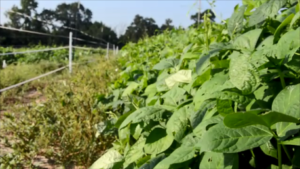- Writer: Adam Russell, 903-834-6191, adam.russell@ag.tamu.edu
- Contact: Dr. Billy Higginbotham, 903-834-6191, billy.higginbotham@ag.tamu.edu
OVERTON – It’s time to plant food plots for white-tailed deer as hunting season approaches, said a Texas A&M AgriLife Extension Service expert.
Dr. Billy Higginbotham, AgriLife Extension wildlife specialist, Overton, has a food plot combination proven to attract whitetails and keep them hooked through the hunting season and beyond.

A plot of cowpeas is a good attractor for white-tailed deer. Combination fall plantings of cowpeas, oats and arrowleaf clover provide forage for deer through winter, spring and into summer. (Texas A&M AgriLife Extension Service photo by Adam Russell)
The combination of winter-hardy oats, iron and clay cowpeas and arrowleaf clover works well in any area that receives 35 inches or more of rainfall each year, specifically in East Texas, Higginbotham said. Cowpeas grow quickly when planted in September when moisture is available. Sprouts are an immediate attractor for deer.
Higginbotham’s strategy is to establish numerous small plots edged by cover so deer will use them during legal hunting hours.
A great way to enhance plots is to provide a transition zone between the edge of the woods and the open food plots so deer feel comfortable moving through screening cover from the woods to the feeding area, Higginbotham said. Allow one or two disc-widths of native vegetation to grow between the food plot and the hard cover to provide secondary cover.
Also consider setting aside at least 1 acre for every 100 acres of habitat in cool season food plots as “sanctuary plots” that are never hunted, Higginbotham said.
“It’s good to rotate food plots each hunting season but I also recommend having a few food plots where deer can feed and are never pressured,” he said.
The cowpeas will be grazed out and/or die back at the first frost, but by then the oats will be established.
“Of all the small grains, deer prefer oats when given a choice,” Higginbotham said. “Be sure to select winter hardy oat varieties to plant because they will provide the bulk of the forage available from first frost until spring green-up.”
The arrowleaf clover will emerge in the spring and last until early June, he said. By then, spring-planted warm-season food plots should be established and able to carry deer through the summer.
To establish plots, shred and disk the area to be planted, Higginbotham said. Consider applying glyophosate to kill vegetation a few weeks before plot preparation if there is heavy vegetation on the site.
The plot should be in a natural opening that will provide enough sunlight for the forages but small enough to provide deer the security of nearby cover, Higginbotham said.
In a clean disked seedbed, broadcast the oats and peas at a seeding rate of 40 pounds per acre each and cover to a depth of 1 inch, he said.
“It is very difficult to disk lightly enough without burying these seeds too deep—a cardinal sin,” he said. “Consider devising a drag out of cattle panels or old tires so the seed can be covered to the correct depth.”
Cowpeas should be inoculated prior to planting. Be sure to purchase the appropriate inoculant when buying seed. Inoculation results in nitrogen fixation by the plants and boosts production.
Arrowleaf clover seed would then be broadcast at 10 pounds per acre and lightly dragged in, Higginbotham said. Like the cowpeas, clover should be inoculated prior to broadcasting. There are pre-inoculated varieties of arrowleaf clover available.
Inoculants minimize nitrogen fertilizer needs at planting and again in late deer season. However, if the oat component of the combination shows signs of “yellowing” during late December or early January, top dress the plots with additional applications of nitrogen at 200 pounds per acre.
“The cowpea-oat-arrowleaf clover-combination has proved to provide early deer hunting opportunities for youth-only and archery seasons when established in early September,” Higginbotham said. “The combination then provides a constant supply of forage for deer into early summer.”
Originally appeared: http://today.agrilife.org/2016/09/02/combination-food-plots-can-attract-deer-year-round/



